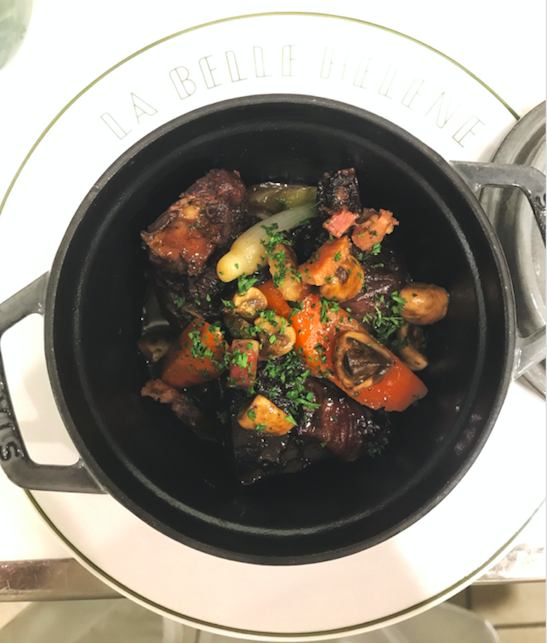
How to braise meat — and some of Charlotte’s best restaurants for braised dishes
“Two quail, two polenta, one broccoli rabe. One short rib, SSSP.” The expo chef at the line calls my next pickup out to me as I wipe the sweat off my forehead.
Good Lord. ‘SP’ was code for VIP in this kitchen which sits open to the dining room. A “SSSP” meant a thrice special person. We finish the push and as I’m refilling my mise en place, I ask the chef, “Who was the short rib for?”
He laughed, “Look at table 19,” replied the chef, head down, stack of tickets in hand.
Joe Montana didn’t choose the hanger steak and fries or roasted chicken. He ordered the braised short ribs sprinkled with a lemon, parsley, garlic gremolata.
He sat there with his wife, bottle of wine on the table, enjoying each bite—from the outside crust to the moist shreds of fatty meat dissolving on the tongue to the soul satisfying sauce spooned over polenta. I had had the dish plenty of times and was confident that each bite exceeded the expectations of Golden Joe.
It was moments like this that stick with me when I reflect on my chef career. And it is those carefully made short ribs that I recall each time I make them for my ‘SSSP’ at home. They’re her favorite.
A very basic guide to braising meat at home:
Braising is a method by which it is possible to turn tough, fatty, and, most of the time, cheap meats into decadent luxuries fit for the MVP but on a benchwarmer’s budget. The process is simple: you brown, you submerge in liquid, and cook. It’s fit for a frugal household and is transferable to many cuts and types of meat from pork shoulder (Boston butt) to chicken thighs to leg of lamb.
The flavor profile of any cuisine can be expressed. For Asian, choose from miso, Chinese 5-spice, soy sauce, coconut milk, Sriracha, or bonito; for Mediterranean, add lemon, oregano, anchovy, tomatoes; and for Middle Eastern, try lots of spices and sweet components like pitted dates. Braising is versatile.
Begin by generously seasoning your piece of meat with at least salt with pepper and other spices at the chef’s (your) discretion. Whether using a pork shoulder, chicken thighs, or other piece of meat, the key to a good start is browning.
Pro tip: Lamb shoulder works great for Middle Eastern braises.
Heat your vegetable oil in a Dutch oven or heavy-bottomed pot until you see a slight wisp smoke and carefully add meat. If you can, slide the meat through the oil before leaving alone. This will help it evenly brown. Once browned all over, remove.
Pro tip: Don’t burn the bottom of the pan. The fond created is the key to making a finishing sauce with plenty of depth.
Add to the pan whatever vegetables you plan to cook. Sauté your chopped vegetables and pick up any browned bits on the bottom of the pot. Onions, carrots, celery, garlic, parsnips and leeks all make good flavor bases. Once cooking, ingredients like herbs, potatoes, or mushrooms can be added based on their appropriate cooking times.
Add meat stock, water, beer, cider, whole milk or any other liquid or combination of liquids you prefer to the pot. Do not cover the meat completely. Leave ⅓ of meat exposed. Cover loosely with a heavy lid—tenting slightly.
Cook in a 325℉–375℉ oven until the meat is tender and falling from the bone (if it has any). The process can take as little as 90 minutes or as long as eight hours for larger cuts like pork shoulder. If you are using a large piece of meat, flip it halfway through the cooking process.
For the sauce: Using a blender, purée the leftover braising liquid and softened vegetables. Strain if you’d like but I tend to keep mine ‘country-style.’ For a richer sauce, add butter or cream.
Pro tip: Spike the sauce with a touch of acidity from vinegar, citrus, or wine to cut through the richness and provide a more well-rounded taste.
The finished product can be split into storage containers with the liquid and frozen for a gourmet treat in the middle of the week.
Bonus: Frozen braised meats are ideal for dinner parties, so you can pay attention to your guests instead of fighting searing hot pans and grease fires in your party outfit.
Good meats for braising:
- Pork shoulder
- Chicken thighs
- Lamb shoulder
- Pork shank
- Leg of lamb
- Short ribs
- Oxtail
And when you run out of inspiration, check out these local restaurants, known for featuring braised dishes on their menus:
The Yolk Cafe: Braised flank steak
His Rock Hill restaurant serves only breakfast, but chef/owner Greg Collier still manages to find a spot for braised meat. The beef flank steak is given a dry rub a couple days in advance, seared, and slow cooked in coffee and a sweet potato vegetable stock. “The dope thing about a braise is you can use the braising liquid pseudo-continuously,” says Collier. When the mojo hash($11.09) is ordered, the line cook slowly heats the meat in the braising liquid before finishing it with a pad of butter to enrich the sauce. The meat is added to sweet potatoes and mushrooms served alongside eggs and scallion pesto. Chef Collier tugs at the end of the towel on his shoulder and stares at the ceiling while trying to find the words to describe it, ”The mojo hash is comfort food, refined.”
Crêpe Cellar: Short ribs
Crêpe Cellar’s red wine braised short ribs over potato herb gnocchi ($27) have been on the menu since the the doors open 9.5 years ago. According to Chef Steve Kuney, “We pan sear the meat. From there, we braise it with onions, celery, carrots, garlic, rosemary and thyme.” All this goes into a 300°F oven, partially submerged in red wine demi glace, for 3-4 hours when the beef shreds with a fork. The gnocchi is a wonderful accompaniment and while I don’t normally advocate for kitchen substitutes, the short ribs served alongside the legendary fries here is a meal worthy of being someone’s last.
La Belle Helene: Coq au vin
Coq au vin (Tuesday special/$32) is one of those classic French dishes you learn in culinary school. And it’s classic for a reason. The name translates literally to ‘rooster in wine’ and historically was a way to cook old male chickens that had grown tough and gamey (in life and love). Like many peasant dishes, it eventually made the transition into fine cuisine. At Uptown Charlotte’s new French brasserie, the coq au vin is braised in a French Burgundy and served with pearl onions, bacon lardons and more.
Barrington’s: Ragoût
Chef/owner Bruce Moffett serves a veal and porcini ragoût with a parmesan gnocchi ($19) at his flagship restaurant, Barrington’s. He cooks the veal with white and red wine, veal stock, tomato, dried porcini mushrooms, and the traditional mirepoix. At chef Moffett’s regional Italian eatery in Myers Park, Stagioni, a similar Italian version can be found. Sugos (‘sauce’ in Italian) made from pork to lamb to beef is often tossed with pastas like rigatoni, fettuccine, or spaghetti in chef Andrew Hurst-Dodd’s seasonal kitchen.
Soul Gastrolounge: Veal short ribs
This appetizer ($11) embraces Asian flavors with a hoisin braise and is served with a five-spice honey. And it may be the best deal in Plaza Midwood at $11. Order this as an entree and ask for a sharp knife. You won’t need it for the fall-apart meat, but it will come in handy defending your plate against unwanted fingers.
Honorable Mentions:
Lawrence Caribbean Restaurant: Oxtail ($11)
China Go Go: Braised pork belly ($9.95)
Bonterra: Foggy Mountain bucatini pasta with Border Springs Braised Lamb ($25)
Que Onda Tacos + Tequila: Braised beef taco (3/$10.95)
VIA CHARLOTTE FIVE


